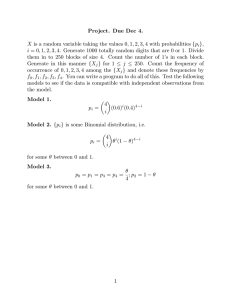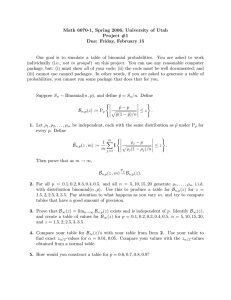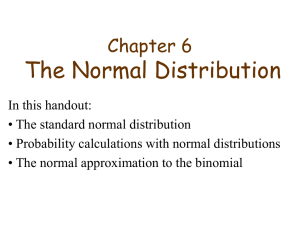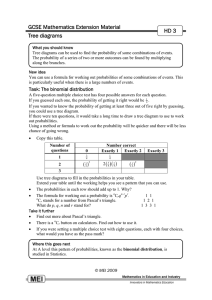Probability An introduction
advertisement
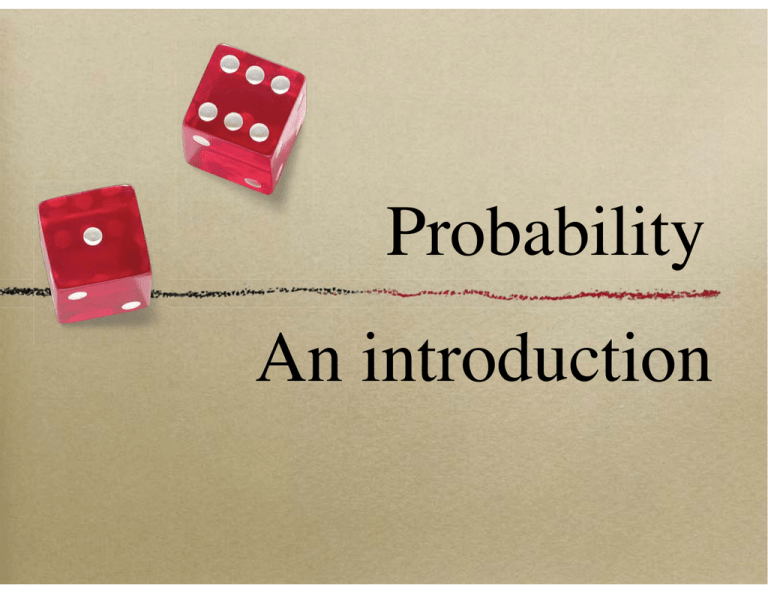
Probability An introduction Probability� Probability theory presents a systematic way to think about� outcomes in a stochastic world Without probability it would be hard to say if an event is likely to occur or not Examples I� What is the probability of:� A newborn will be male? Getting HH in a coin toss? Getting a particular face on a die? In a bag with 1 red, 1 green and 3 blue� balls. What is the probability to draw a 1) red ball, 2) a red or a blue ball? Probability & Frequency� Binomial distributions� Binomial distributions� These are distributions for cases where the outcomes have only 2 possible states� This is the simplest form of probability distribution Examples? Note, the state of each event are binary, but we could talk about sets of events� Think of 2 coins� What are the possible outcomes if we flip 2 coins? Please calculate the probability for each of the possible outcomes Frequency of 2 coin toss� 0.5� 0.4� 0.3� 0.50 0.2� 0.1� 0.25 0.25 0� 0H/2T 1H/1T 2H/0T� Think of 3 coins� What are the possible outcomes if we flip 3 coins? Please calculate the probability for each of the possible outcomes Frequency of 3 coin toss� 0.5� 0.4� 0.3� 0.2� 0.38 0.38 0.1� 0.13 0.13 0� 0H/3T 1H/2T 2H/1T 3H/0T� Think of 6 coins� What are the possible outcomes if we flip 6 coins? Please calculate the probability for each of the possible outcomes Frequency of 6 coin toss� 0.5� 0.4� 0.3� 0.2� 0.31 0.23 0.1� 0.09 0� 0.02 0.23 0.09 0.02 0H/6T 1H/5T 2H/4T 3H/3T 4H/2T 5H/1T 6H/0T� Coin frequency� 0.5 0.5� 0.5 0.4 0.4� 0.4 0.3 0.3� 0.3 0.2 0.2� 0.2 0.1 0.1� 0.1� 0 0 0� 0H/2T 1H/1T 2H/0T 0H/3T1H/2T2H/1T3H/0T 0H/6T1H/5T2H/4T3H/3T4H/2T 5H/1T6H/0T What can you learn from these comparisons? Other binomial distributions� Binomial Distribution 60/40 I� •�A dramatic disease causes death in 60% of the cases, & only 40% people survive. •�What is the likelihood that 10 out of 10 people survive? •� •�Only one possible way to get 10 / 10 .4 * .4 * .4 * .4 * .4 * .4 * .4 * .4 * .4 * .4 =.0001 Binomial Distribution 60/40 II� •�A dramatic disease causes death in 60% of the cases, & only 40% people survive. •�What is the likelihood that 9 out of 10 people survive? Number of combinations� How many different committees of 5 people can you have from a group of 6 people? How many different committees of 8 people can you have from a group of 10 people? How many different committees of 2 people can you have from a group of 10 people? Number of possible ways = n!/[r!(n-r)!] ()! n r n!/[r!(n-r)!] ()! n r 5 of 6 6x5x4x3x2x1 / [5x4x3x2x1x(1)] = 6 8 out of 10 ? 2 out of 10? Binomial Distribution 60/40 II� •�A dramatic disease causes death in 60% of the cases, & only 40% people survive. •�What is the likelihood that 9 out of 10 people survive? Calculating bonomial probabilities� P(r out of n) = number of possible ways one� could get r out of n X probability of each way� Number of possible ways = n!/[r!(n-r)!]� P(9 out of 10) = 0.4^(r) x 0.6^(n-r) = 0.4^9 x 0.6^1 = 0.000157 10!/9!1!=10 P(9 out of 10) = 0.00157 Binomial Distribution 60/40 II� • A dramatic disease causes death in 60%� of the cases. Only 40% people survive.� •�What is the likelihood that at least 7 out of 10 people survive? • A bit more complex ... Calculating bonomial probabilities� P(r out of n) = number of possible ways X Probability of each way Number of possible ways = n!/[r!(n-r)!]� P(7 out of 10) = 0.4^(r) x 0.6^(n-r) = 0.4^7 x 0.6^3 = 0.00035389 10!/7!3!=120� P(7 out of 10) = 0.0425� 7 or more out of 10?� 7 out of 10 + 8 out of 10 + 9 out of 10 + 10 out of 10 When we calculate the probability of an outcome (7), most times we calculate the probaility of the outcome or a more extreme outcome Binomial summary� By using the binomial distribution we can directly calculate the probability of an event (or a more extreme set of events) We can compare this probability to 0.05 and decide if it is significant or not This can be very tedious if we want to c calculate the probability of a range of possible events (x or more extreme) Calculating probabilities� Calculating probabilities I� 6 coins tossed:� n = 6; p = .5; q = .5� Theoretical mean (µ) = np = 6 * .5 = 3� The mean is the expected (unbiased) central� tendency of the distribution� Calculating probabilities II� When we calculate the distributions there are other measures we can easily get Variance (^2) = n *p*q Standard deviation = z = (r-µ) / The z score is very important because it will give us the probability of event r Z scores� z = (r-µ) / � Z for 6 heads is? z = (6-3) / 1.225 = 2.45 Look for z = 2.45 in the Normal distribution table. What is the p? Please calculate I� If you observe that 44 of the 50 infants that were born at MGH yesterday were females, what could you argue? What probability would you give to this event? Would you argue that the probability of females being born at MGH is above 50%? Answer I� n = 50; p = 0.5; q = 0.5 Theoretical mean (µ) = np = 50 * .5 = 25 Variance (^2) = n *p*q = 12.5 Standard deviation = = 3.53 z = (r-µ) / = (44-25) / 3.53 = 5.38 Please calculate II� If you observe that 10 of the 12 times a roulette wheel landed on red, what could you argue? What probability would you give to this event? Would you argue that the probability of the roulette wheel landing on red is above 50%? Answer II� n = 12; p = 0.5; q = 0.5� Theoretical mean (µ) = np = 12 * .5 = 6� Variance (^2) = n *p*q = 3� Standard deviation = = 1.73 z = (r-µ) / = (10-6) / 1.73 = 2.31 Calculating binomial probabilities� We do this by considering the distributional probabilities of the binomial distribution. Which is close to the normal distribution This lets us calculate the probability of a range! Compound Probabilities� Disjunctive probabilities linked by addition� A or B� Conjunctive probabilities are linked by� joint occurrence� A and B� Linda� Linda is vegetarian, she wears sandals even in the winter, she is active in the women literary� society, and her hair usually needs a trim.� Please write down the probability of the� following:� 1) Linda is a bank-teller 2) Linda is a feminist bank-teller Linda� Conjunction: X and Y means lower probability Feminists Banktellers Feminist bank-tellers� Disjunctive and conjunctive� Probabilities� Disjunctive Conjunctive Disjunctive� In a bag with 1 red, 1 green and 3 blue balls. What is the likelihood that you draw a red or a green ball? In a bag with 1 red, 1 green and 3 blue balls. What is the likelihood that you draw a red or a blue ball? Disjunctive probabilities are simple -- they are the probability of the joint event More disjunctive questions� 10% of the students are always late to 15.301 25% of the students shower at least once a week What is the likelihood that a student drawn at random will be tardy or clean student? What is the likelihood that a student drawn at random will be a late or unclean student? Disjunctive summary� Disjunctive probabilities use the word or, but mean the probability or either (both). It is important to note whether the events are independent or not -- what is the overlap between the events. Conjunctive probability The Probability pathway What is the probability for one H and one T? Head (0.5) Tail (0.5) Tail (0.5) Head (0.5) (0.25) H&T (0.5) (0.25) Conjunctive II In a bag with 1 red, 1 green and 3 blue balls. What is the likelihood that in 2 drawings you get 2 red balls?� In a bag with 1 red, 1 green and 3 blue� balls. What is the likelihood that 2 drawings you get 1 red and 1 blue ball?� More conjunctive questions� 10% of the students are always late to 15.301 25% of the students shower at least once a week What is the likelihood that a student drawn at random will be tardy and clean student? What is the likelihood that a student drawn at random will be a late and unclean student? Conjunctive summary� Conjunctive probabilities use the word and, but mean the joint probability. It is important to note whether the events are independent or not -- what is the overlap between the events. Central limit theorem� This is about the behavior of real data!� Approximations of true distribution improves when number of single samples increases As we take more sets of samples, the distribution of samples better approximate the normal distribution Frequency of 6 coin toss (10)� 10� 8� 6� 4� 2� 0� 0H/6T 1H/5T 2H/4T 3H/3T 4H/2T 5H/1T 6H/0T� Frequency of 6 coin toss (100)� 40� 32� 24� 16� 8� 0� 0H/6T 1H/5T 2H/4T 3H/3T 4H/2T 5H/1T 6H/0T� Frequency of 6 coin toss (1,000)� 400 350 300 250 200 150 100 50� 0� 0H/6T 1H/5T 2H/4T 3H/3T 4H/2T 5H/1T 6H/0T� Sampling from another distribution� Using the RAND() function in excel This is a uniform distribution Rounding the numbers to 1-8 This also creates a truncation at the two extreme categories (1 & 8) Random sample from 1-8 (10)� 10� 8� 6� 4� 2� 0� 1 2 3 4 5 6 7 8� Random sample from 1-8 (100)� 25� 20� 15� 10� 5� 0� 1 2 3 4 5 6 7 8� Random sample from 1-8 (1,000)� 150� 120 90 60 30 0 1 2 3 4 5 6 7 8� What about sampling samples?� This time we will take samples of 5 numbers (and take their mean) As we sample more of these samples, how� will the distribution of samples look like?� Sample of 5 sample from 1-8 (10)� 10 8 6 4 2 0 1 2 3 4 5 6 7 8� Sample of 5 sample from 1-8 (100)� 40� 30� 20� 10� 0� 1 2 3 4 5 6 7 8� Sample of 5 sample from 1-8 (1,000)� 400� 300� 200� 100� 0� 1 2 3 4 5 6 7 8� Central limit theorem� This is about the behavior of real data!� Approximations of true distribution improves when number of single samples increases As we take more sets of samples, the distribution of samples better approximate the normal distribution Summary� Probability� This is the base of stattistics... Binomial: A way to calculate probabilities of� events directly Central limit theorem
